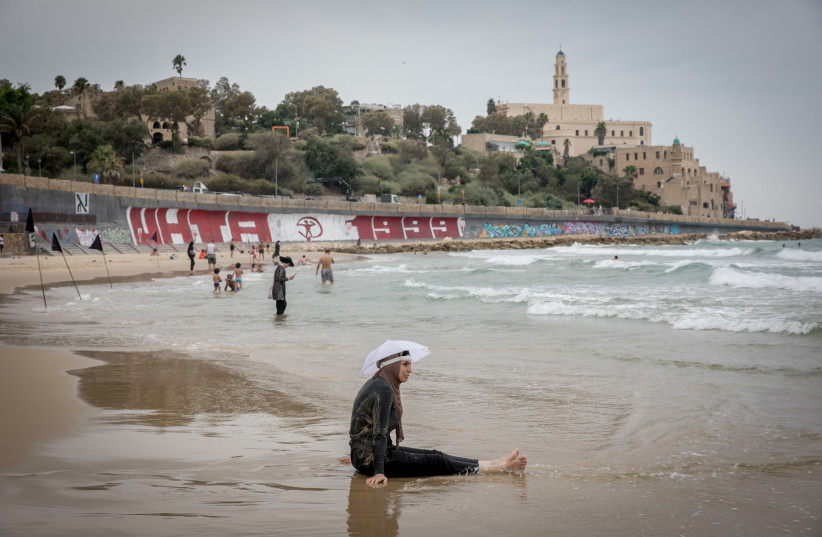Israel’s August had record-breaking heatwave, unexpected rain
Israel experienced its hottest summer months since 1950 across July and August, matching only the scorching summer of 2017, Israel’s Meteorological Service reported over the weekend.
However, August ended on an unusual note with significant rainfall, particularly for this time of year.
When focusing solely on August, the month alone ranked fifth for daily temperatures since 1950, according to the service. Nonetheless, temperatures soared to the second-highest levels on record in the coastal and northern regions – primarily driven by a nearly two-week heatwave.
The years 2021, 2015, 2010 and 1998 were hotter, with 2010 being the hottest. According to the service, most of the hottest summers in Israel were in the last two decades.
August temperatures higher than average
During the day, August temperatures were hotter than the average between 1991 and 2020 by as much as 2 degrees Celsius, depending on the location.
At night, there were also variations, the service said. For example, the coastal plain, the northern valleys and the Negev were 1.5 to 2 degrees Celsius hotter this month, while the Arava was only about 1 to 1.5 degrees Celsius hotter.
 Arab women enjoy the beach in Tel Aviv on a hot summer day. August 13, 2023 (credit: MIRIAM ALSTER/FLASH90)
Arab women enjoy the beach in Tel Aviv on a hot summer day. August 13, 2023 (credit: MIRIAM ALSTER/FLASH90)The meteorological service divided the month into three distinct periods. The first, from the 1st to the 11th of the month, saw Israel experiencing average temperatures. The second phase, characterized by a heatwave, persisted from August 12th to the 24th. Finally, the last stretch, encompassing the 25th to the 31st, brought an unexpected bout of rainfall to the region.
Despite the average temperatures during the first part of the month, some areas had unusually severe heat indexes. On August 1 and 2, temperatures reached 34 to 36 degrees Celsius in the coastal plain and the Shfela region, 37 to 38 degrees Celsius in the northern Negev and northern valleys, and 42 to 44 degrees Celsius in the Jordan Valley and the Arava.
Similar temperatures were recorded on the sixth and seventh.
Evening or nighttime temperatures, however, helped bring the average down.
Israel’s temperatures during the extreme heatwave
During the heatwave, daily maximum temperatures reached 45 to 46 degrees Celsius in the Jordan Valley, 38 to 42 degrees Celsius in the central hills – including 41.7 degrees Celsius in Jerusalem – 36 to 37 degrees Celsius in the northern Golan Heights and Upper Galilee, and 42 to 45 degrees Celsius in the Arava.
In the Shfela region and northern Negev, temperatures ranged from 34 to 37 degrees Celsius; in the coastal plain, temperatures ranged between 33 to 34 degrees Celsius.
The meteorological services reported that elevated relative humidity levels further exacerbated the challenge posed by the intense heat, and this period of exceptionally high daytime temperatures, combined with moderate nighttime conditions, persisted for eight consecutive days, from August 13th to the 20th.
Although, on average, it was not the hottest August ever, some stations broke their highest minimum temperature recorded by a small margin: Beit Dagan with 29.0 degrees Celsius and Negba with 28.2 degrees Celsius. Others were ranked second or third.
Towards the end of the month, temperatures generally remained around average, occasionally dipping below average from August 25th to the 31st. However, on the 28th and 29th, an unexpected spell of rain surprised the nation.
The meteorological service noted that the rainfall was primarily concentrated in the country’s northern regions. Nevertheless, it also extended to the southern coastal plain, affecting areas unaccustomed to rain during this season.
There were also higher quantities for the summer.
In the Jezreel Valley, over 10 millimeters of rain was recorded. In stations around Haifa, up to 9 millimeters of rain was recorded, and in the Jordan Valley, the Galilee, and the Golan Heights, several millimeters of rain fell. There was also some rain in the southern coastal plain, such as 3 millimeters in Kfar Vradim and 2.4 millimeters in Yad Mordechai.
“Although occasionally, we receive light and localized summer rains, this rainfall event was exceptional in terms of both quantity and distribution for July and August,” the service said in its monthly report. “It is interesting to note that in the last two decades, the frequency of significant rain events in the central summer months has increased compared to the past.”





Comments are closed.